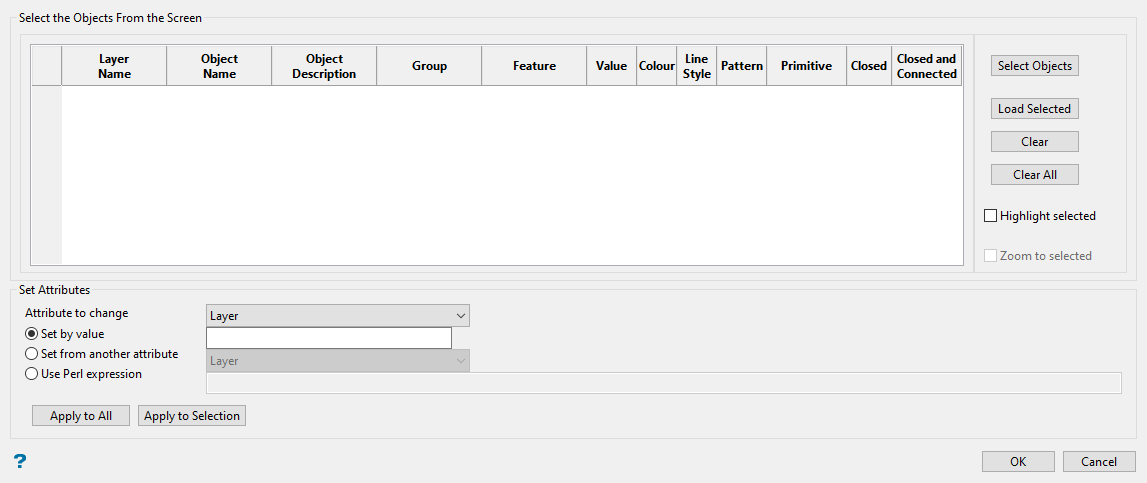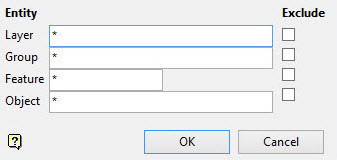Attribute Editor
The Attribute Editor allows you to edit multiple object attributes simultaneously. You can edit all the attributes of design objects, change attributes by a specific value, change attribute values based on other attributes, or assign values using an expression evaluator in Perl.
Instructions
Note: Prior to using this option, load the object(s) in Vulcan that you want to modify.
On the Design menu, point to Attribute Edit, then click Attribute Editor.

Follow these steps:
-
Select the objects you want to modify by populating the table. There are two methods to populate the table:
-
Click the Select Objects button to display the Select By menu.
 Select By menu
Select By menu
 Note
NoteYou can exit the Select By menu at any time by right-clicking or clicking Cancel on the Select By menu.
Object
Click on the object(s) that you want to select. When you finish selecting objects, right-click to return to the Select By menu.
Group and Layer
Click on an object that is part of the group and layer combination that you want to use to select. When you are finished selecting combinations, right-click to return to the Select By menu.
Feature and Layer
Click on an object that is part of the feature and layer combination that you want to use to select. When you are finished selecting combinations, right-click to return to the Select By menu.
Layer
Click on an object in the layer that you want to use to select. When you are finished selecting layers, right-click to return to the Select By menu.
Group
Click on an object in the group that you want to use to select. When you are finished selecting groups, right-click to return to the Select By menu.
Feature
Click on an object that has the feature that you want to use to select. When you are finished selecting features, right-click to return to the Select By menu.
Name
Enter any combination of Layer, Group, Feature, and Object names that you want to select. To include all names for a particular attribute, enter an asterisk ( * ) for that attribute. If you want to exclude a layer, group, feature, or object by name, click the Exclude check box next to the name. Click OK to save selections, and then click Cancel to return to the Select By menu.

Templated Attributes Use this option to display the Select by Attribute panel. All
Click All to select all objects.
-
Highlight the object(s) on the screen, then open Design > Attribute Edit > Attribute Editor.
Note: You must use the main menu to open the Attribute Editor instead of the right-click menu to preserve the highlighted selection.
Use the Clear button to remove any highlighted items from the table.
Use the Clear All button to remove all items from the table.
-
-
Select the Attribute to change by selecting from the drop-down list.
-
Depending on what you select from the Attribute to change list, you will be presented with the options available for the attribute you select.
-
Layer, Name, Description, Group, Feature, and Value all require you to enter the desired value into the textbox.

-
Display the colour palette by clicking on the colour icon, then make your selection.

-
Display the colour palette by clicking on the colour icon, then make your selection.

-
Display the pattern choices by clicking on the pattern icon, then make your selection.

-
For changes made to a primitive attribute, selecting Apply will create a primitive and selecting Don't apply will remove a primitive.

-
For changes made to Closed, select between Close and Open.

-
For changes made to Closed and Connected, select between Close and Open.

-
For changes made to ATTR:Position:Area, use the drop-down list in the table to make your selection.

-
-
Select Set from another attribute to copy the values from one attribute field to another, then select the attribute that you want to copy from drop-down list.
-
Select Use Perl expression to change attributes using Perl, then enter the expression in the text box.
ExampleExamples of Perl expressions
Variable Description $layer layer name (text) $name object name (text) $description object description (text) $group group name (text) $feature feature name (text) $value object value (numeric) $colour object colour index (numeric) $linestyle object line style index (numeric) $pattern object pattern index (numeric) $primitive object primitive (text) $closure if object is closed (0 - opened, 1-closed) Example 1
Assign object value to colour number if object value is positive or 0 if object value is negative.
$value > 0 ? $value : 0
Example 2
Assign to object description the combined Layer name, Object name and Group code using “_” character between them.
join("_", ($layer, $name, $group))
Example 3
Assign to object group the substring of the first ten characters from the description.
substr($description, 0, 10)
Example 4
Assign to object value the square root of calc.
sqrt($calc)
Example 5
Concatenate layer and name with _ between then and assign the result to the object description.
$layer. '_'. $name
Example 6
Specify the numeric format of value and assign to the object ATTR:BACKFILL:MASS.
sprintf("%.3f", $value)
Example 7
Replace a substring, in this case " line " by " poly ". You can include complex instructions between do { }
do { (my $tmp = $name) =~ s/line/poly/i; $tmp }
-
Use one of these methods to apply changes:
- Click Apply to Selection to apply changes to a specific set of objects, click on the number in the first column to highlight the line you want to change. To select additional rows, press and hold the Ctrl key and click on the row numbers you want to change. To select additional adjacent rows, press and hold the Shift key and click the last row you want to highlight, which will highlight all rows in between.
- Click Apply to All to apply changes to all objects.
Click OK to save changes and exit the Attribute Editor, or click Cancel to exit the Attribute Editor without saving changes.

